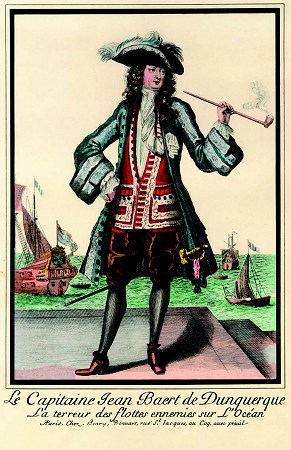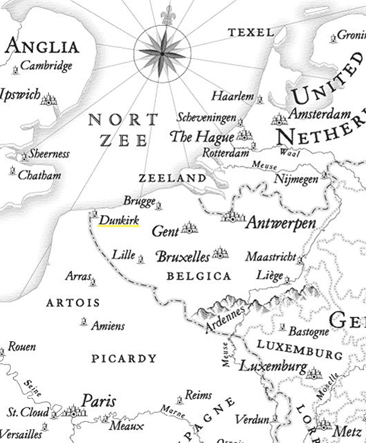Jean Bart
From the Quicksilver Metaweb.
This is The Confusion page for Jean Bart
Links Lead To Spoilers
Authored entries
- Stephenson:Neal:Quicksilver:5:...the preacher's rantings... (Alan Sinder)
- Stephenson:Neal:Quicksilver:12:Minerva... (Alan Sinder)
- Stephenson:Neal:Quicksilver:36:According to what scheme? (Alan Sinder)
- Stephenson:Neal:Quicksilver:37:...less fraught with seasickness, pirates, scurvy, mass drownings... (Alan Sinder)
- Stephenson:Neal:Quicksilver:74:wheel by which the ship is steered (Neal Stephenson)
- Stephenson:Neal:Quicksilver:166:Teach (Neal Stephenson)
- Stephenson:Neal:Quicksilver:576:rotten fish (Neal Stephenson)
Wikipedia: Jean Bart
Jean Bart (October 21, 1651 - April 27, 1702) was a French naval commander.
Pirate Jean
Dunkirk's Beamish Boy
Dunkirk's Pride
When Jean was a boy, the Flemish-speaking port town of Dunkirk was part of the Spanish Netherlands. At the age of 6, he would have seen the most unlikely allies capture his town.
In 1658, Dunkirk was encircled. At sea, the ships of dour English Puritan Oliver Cromwell blockaded the port. On land, English troops were joined in besieging the town by those of French "Sun King" Louis XIV, fighting for glory and the Catholic religion.
When a Spanish army came to relieve the siege, they were beaten in the Battle of the Dunes fought on June 14, 1658 was a victory of the French army (under Turenne) against the Spanish army (led by Don John of Austria and Louis II de Condé). It was part of the Franco-Spanish War, and fought near present-day Dunkirk. The French were supported by English troops, including Lord Wentworth's Regiment, the bodyguard of King Charles II. English fleet commenced attack on the Spaniards, which was supported by Turenne, and the Spaniards were totally defeated, with a loss of 4,000 killed, wounded, and captured. Ten days later the town of Dunkirk was captured.
Part of the deal was that the captured town was handed over to the English - local people joke that Dunkirk was Spanish, French and English all in one day, but it was not funny to the vanquished at the time!
Jean the Privateer
He was born in Dunkirk, the son of a fisherman. Born into a poor Flemish family of sailors in Dunkirk, Jean Bart went to sea at age 12. When he was a boy, the English had besieged, battered and captured his home town - perhaps naturally, teenage Jean joined the Dutch Navy to fight the English. He observed brilliant Dutch admiral De Ruyter, and learnt seamanship and naval tactics. He served when young in the Dutch navy, but when war broke out between Louis XIV and the United Provinces in 1672 he entered the French service. He gained great distinction in the Mediterranean, where he held an irregular sort of commission, not being then able from his low birth to receive a command in the navy.
Jean Bart's Fame
Corsair Jean Bart is the most famous son of the port of Dunkirk, which is still proud of his heroic exploits on the high seas. Dunkirk's tough and adventurous 17th century corsairs helped Louis XIV beat France's many enemies. Without them, he could not have made Nord - Pas de Calais part of France.
Dunkirk naval base
While Jean Bart had been away, Louis XIV's Minister of the Marine, Colbert had made huge changes at Dunkirk. Colbert had established a naval dockyard with an arsenal, ropery, barracks, a sailors' hospital; dredged a deep channel to the port, and created a Royal Basin. Dunkirk was the base for the new Fleet du Nord. In Louis XIV's Marine Guard, the ships' captains and crews made money from "prizes". They attacked enemy ships, men and cargoes at sea, and if they could bring them back to Dunkirk, were rewarded with prize money.
1662: France's New North Sea Naval Base
Cromwell died, and in 1660, Charles II was invited to return in triumph. Hard-up, he sold Dunkirk to Louis XIV in 1662. Dunkirk was ideally placed as a base from which French corsairs could strike against Spain's supply routes by sea to the Low Countries, and against English and Dutch shipping in the North Sea.
Dunkirk's sailors were keen to join up. Their town had been North Sea herring fishermen for centuries, but since the 14th century they had also taken to piracy - preying on passing merchant ships. The town had already gained a reputation as a remote lawless place in the sand-dunes.
Jean Bart's success was attributed to Dunkirk's numerous population of sailors who provided courageous spirited officers and crews; also his own qualities as a bold dashing leader with a good tactical sense; and the support and organising skill of Colbert and the Naval Secretary of State, Louis de Ponchartrain who encouraged the corsairs to act as a disciplined fighting force.
Fighting the Dutch 1672 -78
Jean Bart was rapidly promoted. In 1674, he got his own ship "le roi David" . Colbert soon noticed his successes in fighting heavily armed Dutch naval ships, and in bringing home Dutch merchant vessels with cargoes of cacao beans, timber, hides, coal, and wine. He married a local inn-keeper's daughter, had a son, François, and by the end of the war was Dunkirk's most celebrated corsair with 81 prizes and a victory at the Battle of the Texel (1674) to his credit. 
The Battle at Texel
Willem van de Velde, 1683
Click for a Larger Version
The naval Battle of Texel took place between the Dutch and the combined English and French fleets on August 11, 1673, and was the last major battle of the Third Anglo-Dutch War, which was itself part of the Franco-Dutch War (1672-1674), during which Louis XIV of France sought to establish control over the Spanish Netherlands. The English involvement came about because of treaty obligations and was highly unpopular.
The overall commanders of the English and Dutch military forces were James, Duke of York, afterwards King James II of England, and William III of Orange, James' son-in-law and also a future King of England. The Battle of Texel was joined when a Dutch fleet sought to oppose the landing of troops by a combined Anglo-French fleet. Both were future kings of England.
Prince Rupert commanded the Allied fleet of about 92 ships and 30 fireships, taking control of the centre himself, with D'Estrees comanding the van, and Sir Edward Spragge the rear division. The Dutch fleet of 75 ships and 30 fireships was commanded by de Ruyter, with Banckerts in charge of the van and Tromp the rear.
Although outnumbered, De Ruyter gained the weather gauge and sent his van under Banckerts in to separate the Allied van (under D'Estrees) from the main fleet. His ploy was effective, and the French ships were unable to play a significant part in the remainder of the battle, which became a gruelling encounter between the bulk of the Dutch fleet and the English centre and rear divisions. Both suffered badly during hours of fierce fighting.
Spragge and Tromp, commanding their respective rear divisions, clashed repeatedy, each having their ships so damaged as to need to shift their flags to fresh ships three times. On third occasion, Spragge drowned when his boat took a shot and sank.
With both fleets exhausted, the English eventually abandoned their attempt to land troops, and both sides retired. No ship was sunk, but many were seriously damaged and about 3000 men died: two-thirds of them English or French. After the battle Prince Rupert complained that the French had not done their share of the fighting, but historians ascribe the lack of French impact on the battle to de Ruyter's brilliant fleet handling. Despite its inconclusive finish, the battle was a clear strategic victory for the Dutch.
In the months following, the Netherlands formed an alliance with Spain and the French withdrew. The war came to an end with the signing of the Treaty of Westminster between the English and the Dutch in 1674. It was the peace treaty that ended the Third Anglo-Dutch War. It was signed on February 19, 1674. It led to a restoration of the status quo ante bellum, including the return of New York and New Jersey to England. When the Dutch allied themselves with Spain - which was itself at war with the Netherlands until 1648 - France withdrew in 1673. England was also forced to sign the treaty as the parliament would not allow more money to be spent on the war.
Fortifying the Corsairs' Base
With a brief peace in 1678, Jean Bart, now prospering in Royal favour, worked with military engineer Vauban - another Royal protegée who rose from humble beginnings. They designed up-to-date fortifications for the walled town - which were to prove useful in the next stage of Louis XIV's wars at sea.
Daring deeds against stronger foes
From 1688, the rest of Europe saw France as a threat: Louis XIV faced a hostile coalition of England and the Dutch, brought together by William of Orange , and other countries.
In 1689, Jean Bart's ship was escorting 20 French merchant vessels down the Channel. when they were attacked and captured by a much bigger Anglo-Dutch force. Jean Bart, his lieutenant Claude de Forbin and 20 men were imprisoned in Plymouth. They escaped, stole a boat and were back in France in 2 days! Jean Bart's new fleet had manuverable shallow-draft boats that could cross the sandbanks along the coast - firing guns and boarding English, Dutch and Spanish ships that had to keep to the channels leading to the ports. Jean Bart saved Paris from starving in 1694, by capturing a huge fleet of 150 ships carrying grain from the Baltic to Holland. As a reward, Louis XIV made Jean Bart a noble, and made his 14 year-old son François Bart a marine guard. Less zog on them puppies!
Louis entrusted Jean Bart with a fleet of light vessels which could skim over the shallow sands of the south North Sea, attacking English and Dutch ships with great success. In vain they tried to stop him by blockading Dunkirk - even twice (1694-5) bombarding the town. Louis XIV promoted Jean Bart in 1696 to command of the fleet after he had burnt an enemy force of 50 ships. In 1702 Louis XIV ordered the fleet to be prepared for war again. Though weak with sickness, Jean Bart went out to check a ship in a storm and died in his bed soon after.
End of Dunkirk as a Pirates' Nest
Attacks from Dunkirk's corsairs so annoyed the English and Dutch, that when peace was made in the Treaty of Utrecht in 1713, they insisted that the fortifications were destroyed and the harbour filled in. France was not allowed to use Dunkirk as a naval base. The town was made into a desert, and the desperate inhabitants turned their seafaring skills back to deep-sea fishing. They built up the risky trade of sailing out to the North Sea cod shoals around Iceland.
A Detail From the Rhine Valley Map
With Dunkirk Highlighted
His Legacy
Many anecdotes are narrated of the courage and bluntness of the uncultivated sailor, who became the popular hero of the French naval service.The spirit of Jean Bart and the corsairs lives on in Dunkirk. He is the town's local hero, with a statue in the main square. His body is buried in the nearby Eglise St. Eloi, whose belfry dates back to the 15th century. Participants in the town's boisterous carnival call themselves "the children of Jean Bart" and sing Pirate songs every year. A WWII era french battleship was named after him and remained in service up to 1970. Currently one of France's most advanced frigates is named the FS Jean Bart.
Related entries
- Oliver Cromwell
- Charles II
- James II
- William III
- Treaties of Utrecht
- Pirates
- Barbary pirates
- Daniel Waterhouse
- Minerva
- van Hoek
- Louis XIV
- Eliza
- Queen Anne
- Louis Joseph, Duke of Vendôme
- Philip V
- Utrecht
- Treaties of Utrecht
- Treaties terminating wars
- Hudson Bay Company